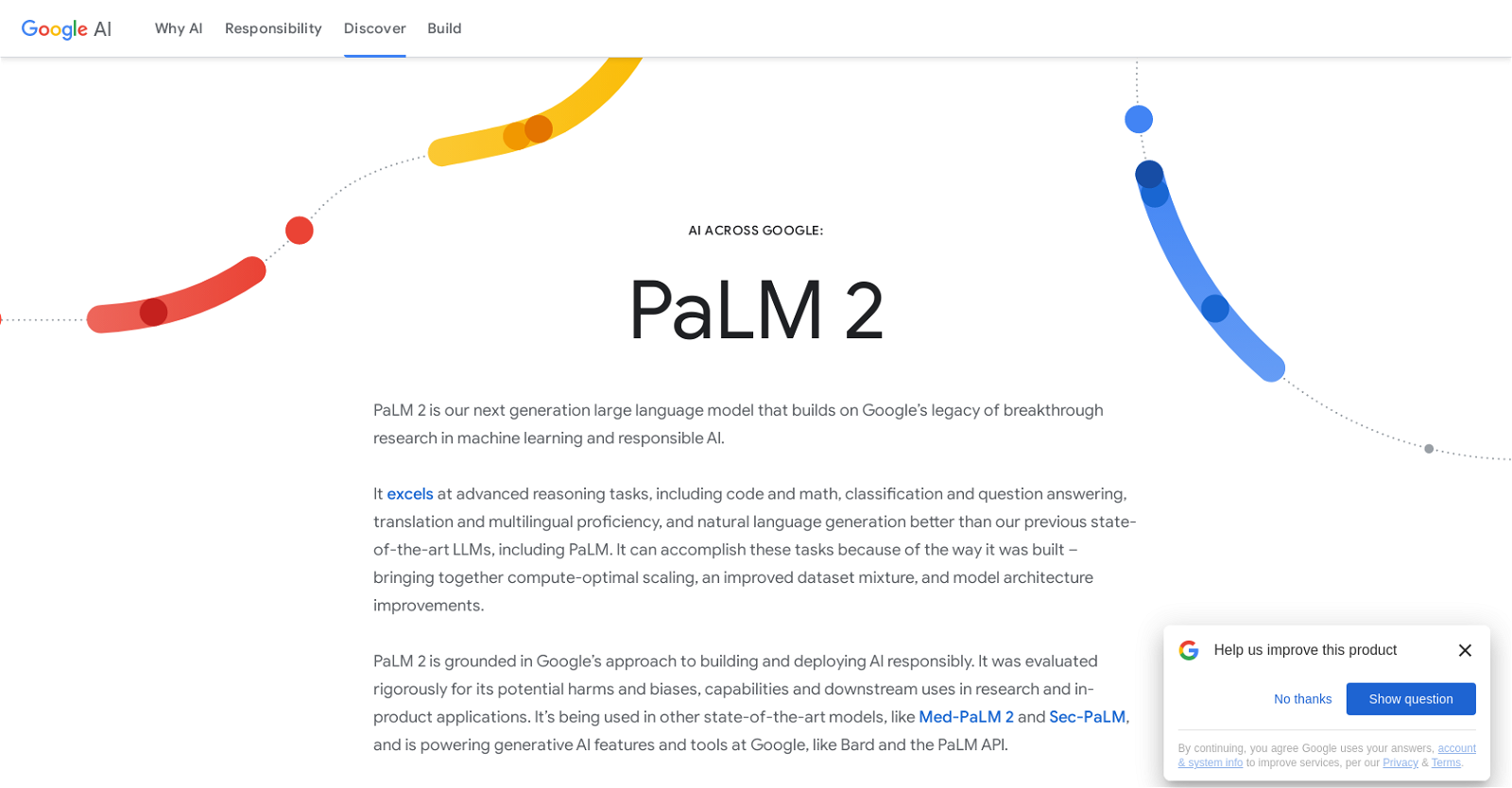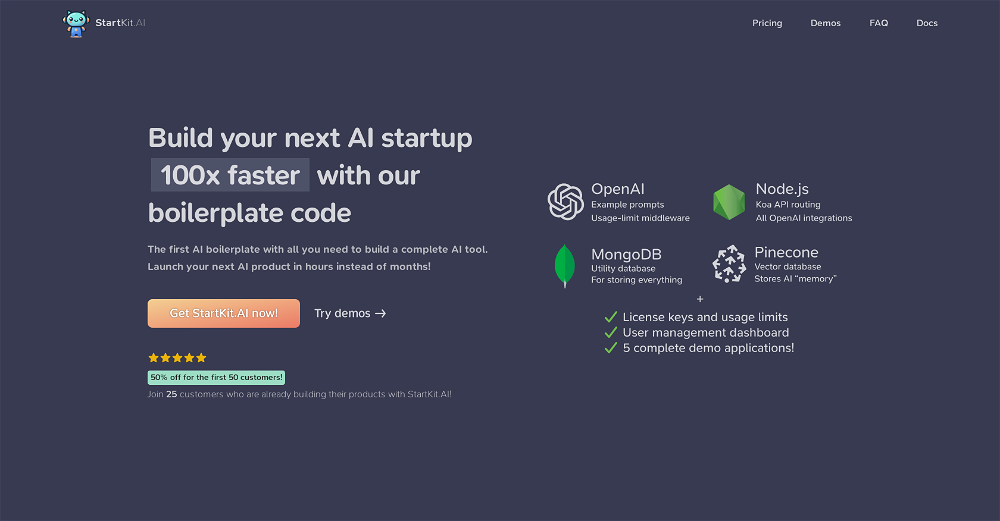What is PaLM 2 by Google?
PaLM 2 is a successor to Google's previous language model, PaLM. It was developed to excel at advanced reasoning tasks, including code generation, question answering, classification, and multilingual proficiency. The model demonstrates improved performance over its predecessor largely due to research advancements in compute-optimal scaling, an improved diversity in pre-training data set mixture, and updated model architecture and objectives. It has been rigorously assessed for potential harms and biases, and is applied in both research and product applications.
How is PaLM 2 different from the original PaLM?
PaLM 2 is different from the original PaLM in multiple ways. It uses compute-optimal scaling enabling it to be smaller but more efficient than its predecessor, with better overall performance, faster inference, and lesser parameters to serve. It also incorporates a more diverse and multilingual pre-training dataset than the predominantly English-only text used in PaLM. These advancements have led to better performance on reasoning tasks and greater multilingual proficiency including improved translation capability.
Why was PaLM 2 developed?
PaLM 2 was developed to build upon Google's legacy of breakthrough research in machine learning and responsible AI. The goal was to create a model that surmounts the limitations of the earlier model and excels at advanced reasoning tasks. It's designed to improve interaction with human language and the ability to compute complex tasks, all while ensuring responsible deployment and alignment with Google's AI principles.
What are the key features of PaLM 2?
Key features of PaLM 2 include excellent reasoning capabilities with a prowess in understanding the nuances of human language, improving translation and multilingual proficiency. PaLM 2 also exhibits advanced coding skills, and is capable of generating specialized code, even in languages like Prolog, Fortran, and Verilog. An additional feature is its built-in control over toxic generation and its improved multilingual toxicity classification capabilities.
What types of tasks is PaLM 2 designed to excel at?
PaLM 2 is designed to excel at advanced reasoning tasks such as code and math, classification, question answering, translation, and natural language generation. It can decompose complex tasks into simpler subtasks and understand idioms, riddles, and ambiguous and figurative meaning of words.
What advancements contribute to the improved performance of PaLM 2?
Three key advancements contribute to the improved performance of PaLM 2: the use of compute-optimal scaling which makes the model more efficient; an improved dataset mixture that includes hundreds of human and programming languages, mathematical equations, scientific papers, and web pages; and an updated model architecture and objective which allows it to learn different aspects of language.
How does PaLM 2 handle potential harms and biases?
PaLM 2 handles potential harms and biases by being evaluated across a range of potential downstream uses including dialogue, classification, translation, and question answering. During its development, sensitive personally identifiable information is removed, duplicate documents are filtered to reduce memorization, and analysis of how people are represented in pre-training data is shared. It also has built-in control over toxic generation and demonstrates improved multilingual toxicity classification capabilities.
In what languages is PaLM 2 capable of coding?
PaLM 2 can code in popular programming languages like Python and JavaScript. Additionally, it can generate specialized code in languages like Prolog, Fortran, and Verilog.
What datasets was PaLM 2 pre-trained on?
PaLM 2 was pre-trained on a large amount of data including web page data, source code, and other datasets. This vast and diverse pre-training corpus includes hundreds of human and programming languages, mathematical equations, scientific papers, and web pages.
How does PaLM 2 understand nuances in human language?
PaLM 2’s improved understanding of nuances in human language comes from the vast and diverse pre-training dataset and improved model architecture. It excels at understanding riddles and idioms, requiring comprehension of ambiguous and figurative meanings.
How does PaLM 2 contribute to Google’s generative AI features and tools?
PaLM 2 contributes to Google's generative AI features and tools by powering AI features like email summarization in Gmail and brainstorming and rewriting in Docs. It is also integrated into products like Bard (a tool for creative writing and productivity) and the PaLM API (a platform for developing generative AI applications).
What is the connection between PaLM 2 and Bard?
PaLM 2 plays a crucial role in powering Bard, a tool by Google that aids in creative writing and productivity. It uses the advanced language understanding and generative capabilities of PaLM 2 to help users enhance their imagination and bring their ideas to life.
How can developers use the PaLM API?
The PaLM API allows developers to build generative AI applications using Google’s next generation large language model, PaLM 2. It provides a platform for prototyping generative AI ideas and integrates PaLM 2's capabilities within Google Cloud's Vertex AI.
How does PaLM 2's computation-optimal scaling work?
In PaLM 2, computation-optimal scaling works by scaling the model size and the training dataset size in proportion to each other. This technique makes PaLM 2 smaller than PaLM, but more efficient with better performance, including faster inference, fewer parameters to serve, and a lower serving cost.
What improvements have been made in PaLM 2’s model architecture and objectives?
There have been several improvements in PaLM 2’s model architecture and objectives compared to its predecessor. PaLM 2 features an improved architecture and has been trained on a variety of different tasks, all of which help the model to learn different aspects of language better.
How was PaLM 2 evaluated?
PaLM 2 was evaluated for its potential harms and biases, capabilities and downstream uses in research and in-product applications. It was benchmarked on tasks such as WinoGrande and BigBench-Hard, and was found to be significantly more multilingual than the previous model, achieving better results on benchmarks such as XSum, WikiLingua, and XLSum. Additionally, it improved translation capability over PaLM and Google Translate in languages like Portuguese and Chinese.
How does PaLM 2 handle ambiguous and figurative meanings?
PaLM 2 has been trained to understand the ambiguous and figurative meanings of words, rather than just their literal meaning. By being pre-trained on a diverse dataset and improved model architecture, it excels at understanding riddles and idioms, which often require such comprehension.
Can PaLM 2 generate specialized code in languages like Prolog, Fortran, and Verilog?
Yes, PaLM 2 is capable of generating specialized code in languages like Prolog, Fortran, and Verilog. It has been pre-trained on a large amount of source code, which has equipped it with the knowledge to generate such specialized code.
What is the role of PaLM 2 in Google's approach to responsible AI development?
PaLM 2 plays a key role in Google's approach to responsible AI development. It aligns with Google's principles of responsible AI development and commitment to safety. During its development, potential harms, biases, capabilities and downstream uses were rigorously evaluated. Sensitive personally identifiable information was removed from the pre-training data, and potential harms related to toxicity levels and social bias were evaluated.
How is PaLM 2 being used in other state-of-the-art models?
PaLM 2 is being used in other state-of-the-art models like Med-PaLM 2 and Sec-PaLM. These applications demonstrate the versatility and adaptability of PaLM 2, as it can be integrated into various models and areas, further enhancing its generative capabilities and efficiency.













